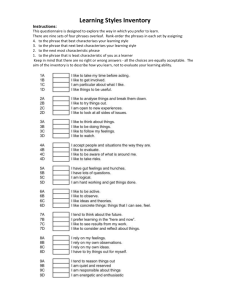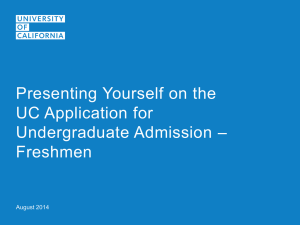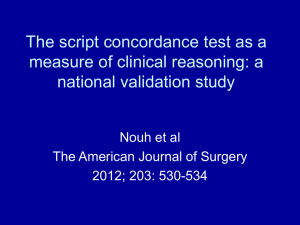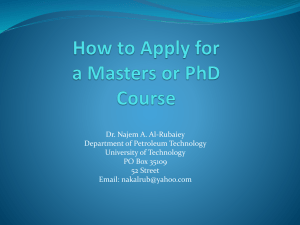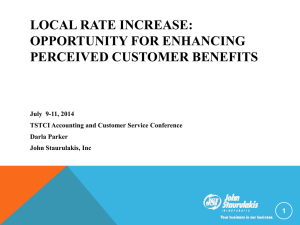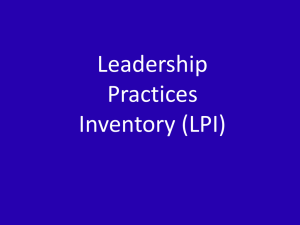Impact of Faculty Learning Styles on the Integration of
advertisement
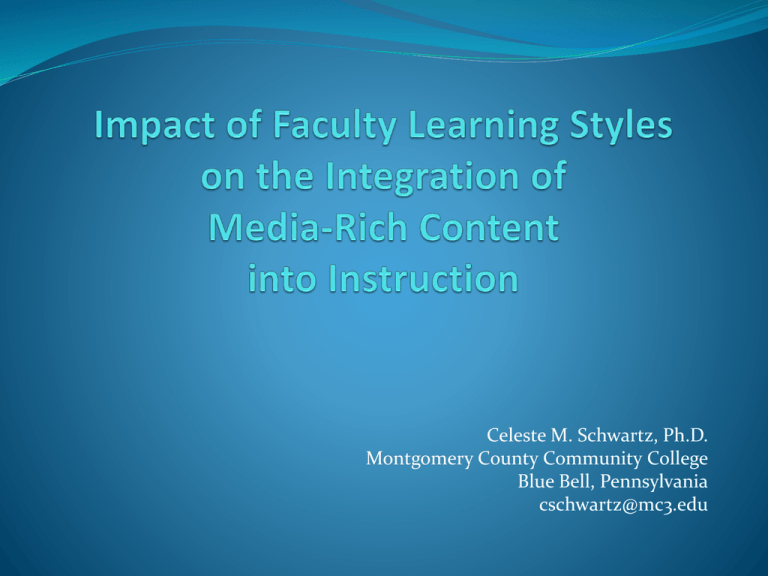
Celeste M. Schwartz, Ph.D. Montgomery County Community College Blue Bell, Pennsylvania cschwartz@mc3.edu Background Higher Education Challenges National Education Technology Plan’s (NETP) request that faculty use technology to create engaging learning environments. 2. EDUCAUSE 2009 Teaching and Learning Technology Challenges of student engagement and faculty integration of new technologies into teaching and learning. 3. Federal Higher Education Challenge to increase the percentage of 2- and 4- year degree completers. 1. Background Why do some faculty embrace and integrate new proven technologies sooner than others? The Gap Little is known regarding different learning styles of faculty and its impact on their use of technology in teaching. Theories Learning Styles & Technology Implementation Based on human learning and development theories, and information systems theories Theories Used Technology Acceptance Model (Davis) - the perceived usefulness and perceived ease of use of a technology Kolb’s Experiential Learning Theory (Kolb) - an individual’s preferred learning style Research Questions Are there differences, based on their learning styles, in community college full-time faculty’s perceived usefulness of integrating media-rich content into their courses, after controlling for effects due to age? 2. Are there differences, based on their learning styles, in community college full-time faculty’s perceived ease of integrating media-rich content into their courses, after controlling for effects due to age? 3. Is there a significant correlation between community college full-time faculty’s perceived usefulness of integrating media-rich content into their courses and their perceived ease of integrating media-rich content into their courses? 1. Media-rich Content Definition Media-rich content is defined as technologies that enable learners to participate in an engaging interactive learning environment supported by technologies. Media-rich content provides learners with the ability to see, hear, and interact with multiple communication streams synchronously and asynchronously. Instruments used in the study Demographic questionnaire Kolb’s Learning Style Inventory (LSI) Davis’s Technology Acceptance Model (TAM) Demographics Instrument Age Discipline Gender Professional Development Integration of Media-rich content Kolb’s Learning Style Inventory Kolb’s Experiential Learning Theory Two preference dimensions perception dimension - two opposite dimensions for perception of the experience are concrete experience (CE) and abstract conceptualization (AC) processing dimension - two opposite dimensions for processing the experience are reflective observation (RO) and active experimentation (AE). Kolb’s Learning Style Inventory Combining one perception preference and one processing preference results in one of four learning styles. 1. 2. 3. 4. Diverger (CE & RO) Converger (AC & AE) Accommodator (CE & AE) Assimilator (AC & RO) Learning Modes Concrete Experience (CE) Active Experimentation (AE) Reflective Observation (RO) Abstract Conceptualization (AC) Learning Style Types CE Accommodator Diverger AE RO Converger Assimilator AC Data Analyses Research Question 1 & 2 used a casual-comparative research design Research Question 3 used a non-experimental correlational design. Davis’s Technology Acceptance Model Perception Survey Perceived Usefulness (PU) Perceived Ease of Use (PEOU) Anticipated Findings Faculty members’ preferred learning styles identified as converging or accommodating will be more likely to perceive usefulness of integrating media-rich content into their courses than faculty members’ identified as diverging or assimilating. 2. Faculty members’ preferred learning styles identified as converging or accommodating will be more likely to perceive ease of integrating media-rich content into their courses than faculty members’ identified as diverging or assimilating. 3. Significant correlation between faculty’s perceived usefulness of integrating media-rich content into their courses and their perceived ease of use of integrating media-rich content into their courses. 1. Findings Respondents from the sample population were 149 (valid responses) which represented a slightly higher number of female respondents to the sample population. The respondents represented 35 academic disciplines and 5 academic divisions. Participants LSI types 34 divergers 50 assimilators 35 accommodators 30 convergers Findings Analyses for alpha scores Cronbach alpha scores for LSI learning cycle mode CE, RO, AC, &,AE were all above the acceptable value of .70. Cronbach alpha scores for TAM PU and PEOU were also above the acceptable value of .70. NOTE: Because Cronbach alphas were strong the research questions could be examined. Analyses of the relationship between age and PU, age and PEOU, and age and LSI type Pearson product moment found no significant correlation between age and PU scores Pearson product moment found a small relationship between age and PEOU scores. As expected there was no relationship between age and LSI type. Findings Main Analyses Anova was not able to explain the observed differences in PU scores based on LSI scores. Ancova was run to determine the impact of LSI type on PEOU scores after controlling for age. The covariate age did not appear to contribute meaning information Anova found that the LSI scores impacted the PEOU scores based on the finding with a more stringent alpha level of p <.017. Pearson product moment correlation found that there was a significant positive relationship between PU and PEOU.(p < .001). Findings Post hoc analyses were performed to determine the differences in PEOU scores by each of the LSI learning types. As seen in the next slide accommodator and converger have similar mean scores and the mean scores of diverger and assimilator are similar. (NOTE: this shows that the processing dimension is what ties accommodator and converger together and diverger and assimilator together Based on these findings PEOU data were reanalyzed using ANOVA and showed statistically significant results, F (1, 1470 = 10.52), p = .001 Estimated marginal means from ANOVA of PEOU scores by LSI type LSI Learning Type n Mean SD Std. Error Lower Bound Upper Bound Diverging 34 28.47 7.300 1.197 25.58 31.36 Assimilating 50 29.26 7.323 .98 26.88 31.64 32.34 6.949 1.180 29.49 35.19 33.03 5.986 1.275 29.96 36.11 Accommodating Converging 35 30 Confidence Interval = 98.3% Interpretation of the Findings Age was not a variable that affected the PU or PEOU scores and ultimate use of technology LSI type does not help to clarify observed differences in PU scores. LSI type does impact PEOU scores. It is not surprising that active experimenters will have higher PEOU scores compared to reflective observers. Based on the TAM PEOU questions relating to how faculty perceived ease of use of integrating media rich content into their courses. the process closely aligned with the act of doing. Doing Watching Active Experimentation (AE) Reflective Observation (RO) Accommodating (CE/AE) Diverging (CE/RO) Converging (AC/AE) Assimilating (AC/RO) . Feeling Concrete Experience (CE) Thinking Abstract Conceptualization (AC) Findings Faculty who preferred Active Experimentation showed higher Perceived Ease of Use scores than faculty with the Reflective Observation orientation. Implications for the Findings Professional Development staff should ensure that brainstorming, discussion groups, observation and creative problem solving are integrated into the handson training. Professional Development staff should provide a teaching and learning model that faculty could emulate. Faculty should have an understanding of their own learning styles and an understanding of the different learning styles of their students. Limitations of this Study Full-time teaching faculty from two large suburban mid-Atlantic community colleges. Media-rich content Other theories Self-report of attending specific professional development Recommendations for actions Faculty professional development offerings should include programs that encompass all aspects of Kolb’s learning cycle. Colleges should encourage the integration of proven technologies into teaching and learning. Faculty should include approaches and technologies into their courses that take into account students’ preferred learning styles. QUESTIONS Celeste M. Schwartz cschwartz@mc3.edu
